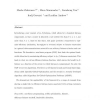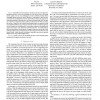CN
2007
13 years 11 months ago
2007
We consider the flow-level quality of service (QoS) seen by a dynamic load of rate adaptive sessions sharing a bottleneck link based on fair share bandwidth allocation. This is o...
COR
2008
13 years 11 months ago
2008
Introducing a new concept of (, )-fairness, which allows for a bounded fairness compromise, so that a source is allocated a rate neither less than 0 1, nor more than 1, times...
COMCOM
2008
13 years 11 months ago
2008
With the unique features of spatial multiplexing and interference suppression, Multiple Input Multiple Output (MIMO) techniques have great potential in the improvement of network ...
CCGRID
2010
IEEE
14 years 23 days ago
2010
IEEE
We develop a novel framework for supporting e-Science applications that require streaming of information between sites. Using a Synchronous Dataflow (SDF) model, our framework inco...
ICC
2007
IEEE
14 years 3 months ago
2007
IEEE
Abstract--Ethernet passive optical networks (EPONs) are designed to deliver services for numerous applications such as voice over Internet protocol, standard and high-definition vi...
ACCESSNETS
2009
Springer
14 years 3 months ago
2009
Springer
In EPONs, differentiated services enable higher quality of service (QoS) for some queues over others. However, owing to the coarse granularity of DiffServ, DiffServ in EPONs can ha...
ISORC
2002
IEEE
14 years 4 months ago
2002
IEEE
The increasing use of wireless networks has necessitated the development of a wireless networking infrastructure that supports quality of service (QoS) for multimedia communicatio...
INFOCOM
2002
IEEE
14 years 4 months ago
2002
IEEE
Abstract—Input buffered switch architecture has become attractive for implementing high performance routers and expanding use of the Internet sees an increasing need for quality ...
IWQOS
2004
Springer
14 years 5 months ago
2004
Springer
— Equitable bandwidth allocation is essential when QoS requirements and purchasing power vary among users. To this end, we present a mechanism for bandwidth allocation based on d...
MOBICOM
2004
ACM
14 years 5 months ago
2004
ACM
—The traffic load of wireless LANs is often unevenly distributed among the access points (APs), which results in unfair bandwidth allocation among users. We argue that the load ...


